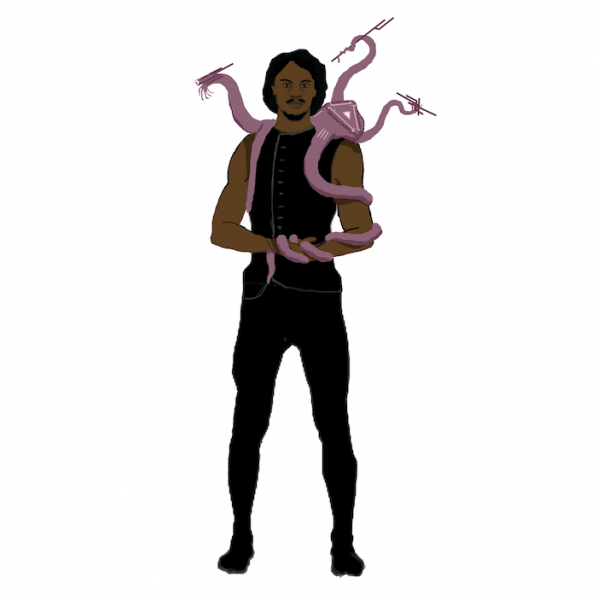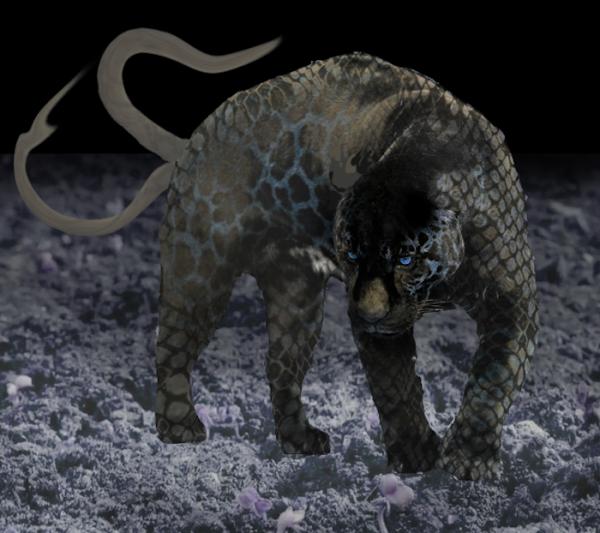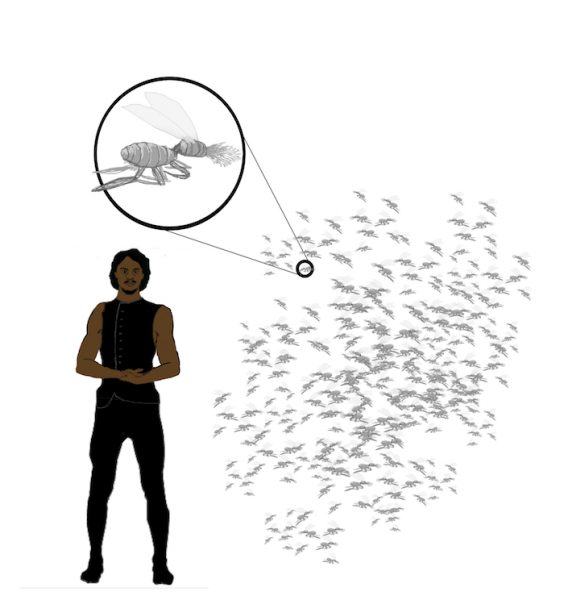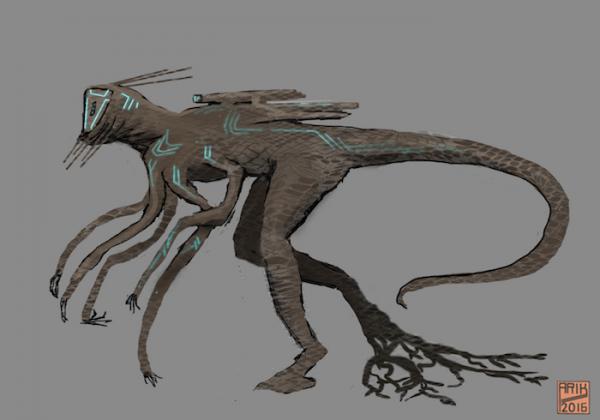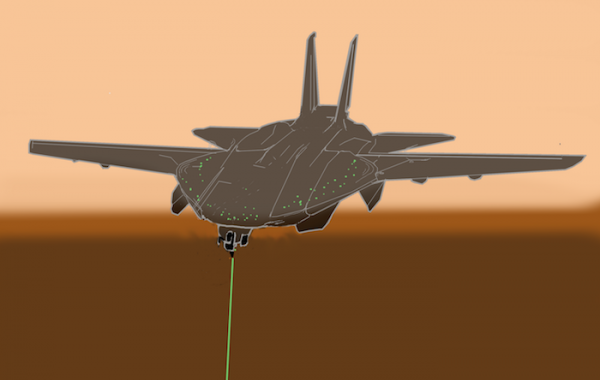BY LETTER
Guardbots, Securitybots and Warbots
Technology > Application > Weapons > Personal Weapons
Technology > Application > Robotics
Culture and Society > Politics & Government > Warfare
Technology > Application > Robotics
Culture and Society > Politics & Government > Warfare
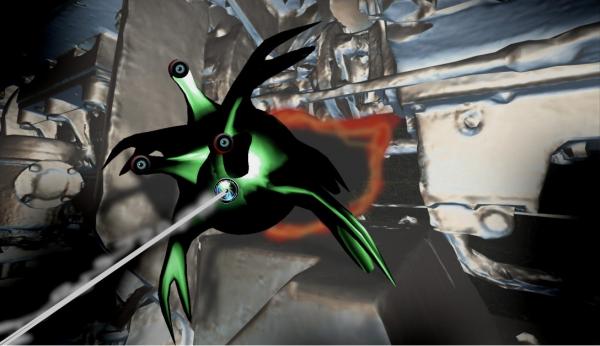 Image from Steve Bowers |
Snapshot: Buildup to War
'Royal Guard to Readiness-Level 2; full mobilisation'. Precisely a second after receiving the coded order Barrack Alpha began to hum with activity. The vaulted facility stretched for a kilometre through the bedrock, as wide as it was deep. Thousands of semi-circular alcoves rose from its polished floor, while nozzles descended from the byzantine layer of pipes clinging to the ceiling.
The Barrack echoed as the nozzles began releasing their smart matter sprays. Dozens of smatter breeds were layered upon one another, forming a growing oily hemisphere within each alcove. Once their onion-like creations reached a metre in width, the nozzles halted. An observer would have perceived little activity for a moment as the nascent gelbots finalised their smatter integrations. The oily texture faded as dark bronze armour scales fused along the surface of each unit, punctuated by sensor blisters. The hemispheres retracted into squat barrel-forms before rising on six flexible limbs.
As the warbots assumed their default form, hatches all along the interiors of the alcoves opened. Lightening fast bot-arms transferred blocky components from storage to the gelbots; depositing them in cavities along the barrelled bodies that snapped closed in an eyeblink.
Again a pause swept the facility as the bots took a moment to itemise and rearrange their combat equipment. Limbs sprouted, small and large, clutching a variety of sensors and weapons. Final checks complete, the first legion of gelbots left their alcoves and marched towards the waiting vactrain carriages in the Barrack walls. There they would be whisked to the Kingdom's border with the Confederation of Hafk, to patrol and guard until relieved or RL-1; War.
As the thousands of gelbots left the facility, the nozzles roared to life again. Laying down the next legion. Barely a minute had passed since Barrack Alpha had sprung to life. It would not fall silent for some hours yet.
Archeological resimulation of events prior to the destruction of Oshya, fourth planet in the Uhir system (Outer Volumes).
Since ancient times bots have filled a myriad of roles in conflict situations; ranging from small, wearable forms for wilderness protection to planet busting autowars. Whilst sophont combat has not completely disappeared, it is quite rare outside of ritual or ceremonial roles. Most clades are neither physically nor mentally capable enough to stand a chance against machines specifically designed for combat at or above their S-level. Indeed combat bot minds and bodies are usually the result of millions of subjective years of virch evolution and redesign, creating fighters vastly more effective than anything natural evolution has to offer. The few exceptions to this rule are those who have been augmented enough to become sophont versions of combat bots themselves. While some polities staff their militaries with these clades, the vast majority opt for non-sophont bots for practical and ethical reasons.
Despite their great diversity there are various traits that any combat bot will likely possess:
- High quantities of computronium resulting in the world being perceived as moving significantly slower than baseline norm (at least one order of magnitude)
- Superturing-level minds and ainstincts granting near-perfect short and long term tactical decisions to be made rapidly
- Advanced sensory processing and agility make it possible for even simple bots to track, prioritise and hit scores of targets as fast as their body can move
- Enhanced artificial muscles with regenerative braking allow limb, turret and other movements faster than baseline senses can register
- The weapons used by all forms of combat bot include (but are not limited to): melee, ballistic, missiles, amat flechettes, beam, particle, chemical, cyber and in some cases psychological/memetic. Understandably it is rare that a combat bot can be countered with anything but another combat bot, or overwhelming numbers.
A full accounting of the types and uses of combat bots can fill its own encyclopaedia (indeed the Keter Standard warchives Library is one of the largest topic-specific encyclopaedias ever created). Below is an overview of the notable models that form a representative cross section.
Wearable Guardbot: Often these guardians double as clothing and fashion items. A wearable guardbot will monitor the environment for threats, acting to neutralise the most severe in accordance with local laws and their owner's wishes. Since combat situations may require decisions to be made faster than most sophont minds are capable of, some guardbot designs require an up-to-date simm of their owner. This simm acts as the bot's conscience, as well as enabling it to decide battle priorities. If of sufficient size a wearable guardbot may fully envelop its owner, acting both as weapon and armour.
Protector-Pet: Designed to double as a loving companion as well as a guardian, these bots have forms similar in appearance to animals (in combat situations such camouflage is dropped in favour of the most efficient operational form and behavior). In some cultures this mimicry is pushed to the extent that it requires close (internal) study to determine if a pet is a natural organism or a protector in disguise. Capabilities vary, with aesthetics often emphasised over efficiency; for this reason protectors are more commonly used in ritual combat or in low risk zones, such as rural areas with dangerous wildlife (notable exceptions include the 100 tonne ArachnoTank-9 series deployed during Second Vec War). Despite this, Protector-Pets can still be extremely effective and deadly; laser eyes, diamondoid claws, sonic screams and mobility denial tails are just some of the defences common to this form of bot.
Synsect Swarm: Individually low mass and weak the power of a swarm comes from its size and coordination. Individual synsects can be fitted with: OPA camo-skin, stinger micromissiles (with chemical, nanotechnological and amat payloads), disassembler heads, single-watt laser (effective when thousands of synsects fire at once), replicator organs and gripping limbs to act as crude utility foglets. Swarms are the archetypal Terragen weapon; possessing a status in many cultures akin to firearms and swords in historical societies.
Gelbot Warrior:. A pinnacle breed of military technology. First deployed in the Second Vec War by Metasoft, this configuration of combat technology is one of the most common and effective in the known galaxy. As with their domestic and industrial cousins, gelbot warriors possess a smart matter body capable of changing shape, size and other material characteristics. Warrior forms tend to have less capacity to change their volume, a tradeoff that grants them greater durability. In the event that sections of their body are damaged, they can shed these parts and redistribute their mass to keep fighting at optimum efficiency (making a fight against a warrior one of attrition). Within their polymorphic structure all manner of weapons are held in compressed form, ready to be deployed at any point on the unit's body. In the blink of an eye a warrior can go from its passive form to deploying bladed tentacles, scores of kilojoule lasers, missile launchers, acid sprayers and much, much more. Ultratech designs may be fitted with Q-mirrors, magmatter power loops and, in one historic case, reactionless drive cores (whilst powerful these transapientech additions cannot be repaired or replaced by the warrior if damaged). Most warriors are neumann capable and utilise FITs for self-repair, ammunition renewal, and the manufacture of extra weaponry (making them mobile warchives). Given sufficient time, a warrior's internal FIT systems can also be used to manufacture additional types of combat bots (synsects are the most common), to act in roles from recon to resupply.
One of the most dangerous aspects of warriors is their ability to split into smaller forms and merge into larger ones as needed. Unless all warrior mass is disposed of during a battle, the victors risk a later insurgency as smaller pieces act as hidden spores to grow the army anew. For the most part such unmanaged replication tactics are illegal, although this hasn't prevented some foolish or misguided groups from attempting it, sometimes rendering entire solar systems uninhabitable (hazard level 8) in the process.
Hyperflyer: VTOL aerial combat bot capable of hypersonic and suborbital flight. Deployed on planets and within large habs for rapid, long distance engagement and ground support. Alongside the regular diversity of possible armaments, hyperflyer squadrons can be used to deploy swarms and other combat bots. Some notable designs feature power and propulsion systems using conversion technology and/or amat. Either is sufficient for hyperflyers to act as interplanetary and extended orbital fighters (in cases such as this it is not unheard of for hyperflyers to perform amat-kamikazes as a last resort). Conversion reactor equipped units are especially durable, capable of easily refueling from the atmosphere.
Whilst rarer than other types of combat bot some hyperflyers are capable of reproduction. Famously the Zoeific Biopolity has produced high-quality versions over the past four millennia thanks to the Violorium; a gas giant teeming with hyperflyer squadrons in a constant state of conflict, replication, and adaptation.
Related Articles
- ::GN News Warehouse comments::
- Biobots
- Biowar
- Combat Jacket
- Combat Threads
- Drone Weaponry
- Forge Integrated Technology (FIT)
- Gelbot
- Guardweb
- Hand-held Lasers
- Laser Weapons
- Robot
- Robotics
- Security Bush
- Smart Weapons - Text by M. Alan Kazlev, from Anders Sandberg's Big Ideas Grand Vision
Weapons with have varying amounts of intelligence in them (rarely more than turingrade). The simplest Smart Weapons link to a control-command subturing and give the owner the ability to shift between types of ammo, see through the aimpoint camera etc. This kind of connection is necessary for use in teamware, and is practically standard among even the simplest baselines. The scramjet bullets of the sabot pistols of Trillicon have built in cameras and some limited steering capabilities. Zetatech's Marksman Gun is equipped with a n expert system that can act as a point defence or drone if placed on a tripod or suitable vehicle (although the price tag deters most people). - Softbots and softvecs
- Symaiote and Symbiote
- Synsects
- Weapon Harness
Appears in Topics
Development Notes
Text by Ryan B (Rynn)
Initially published on 30 March 2016.
Initially published on 30 March 2016.
Additional Information
A story about a habitat attacked by warbots by Ryan B (Rynn) here:
Hunted
Hunted
